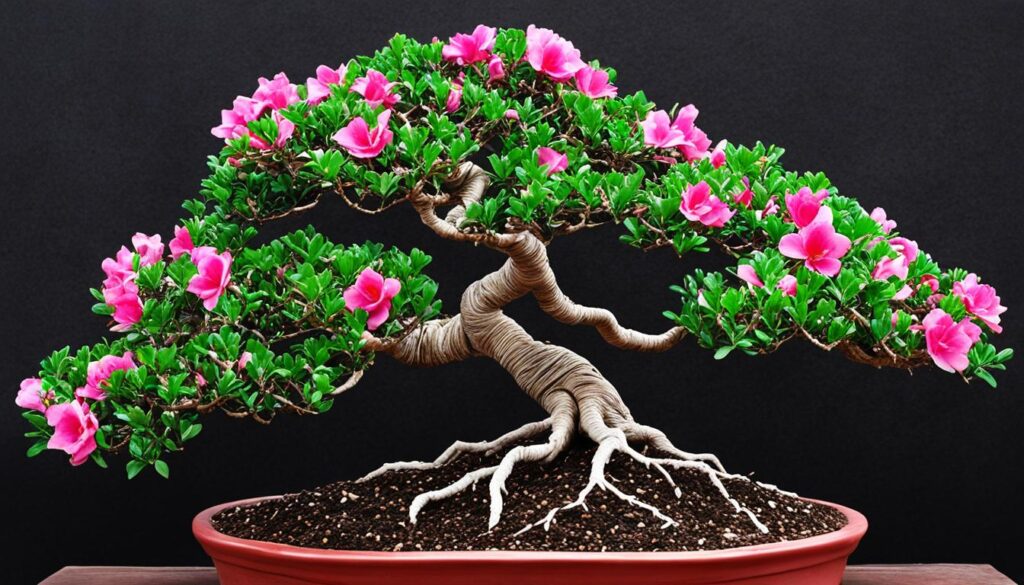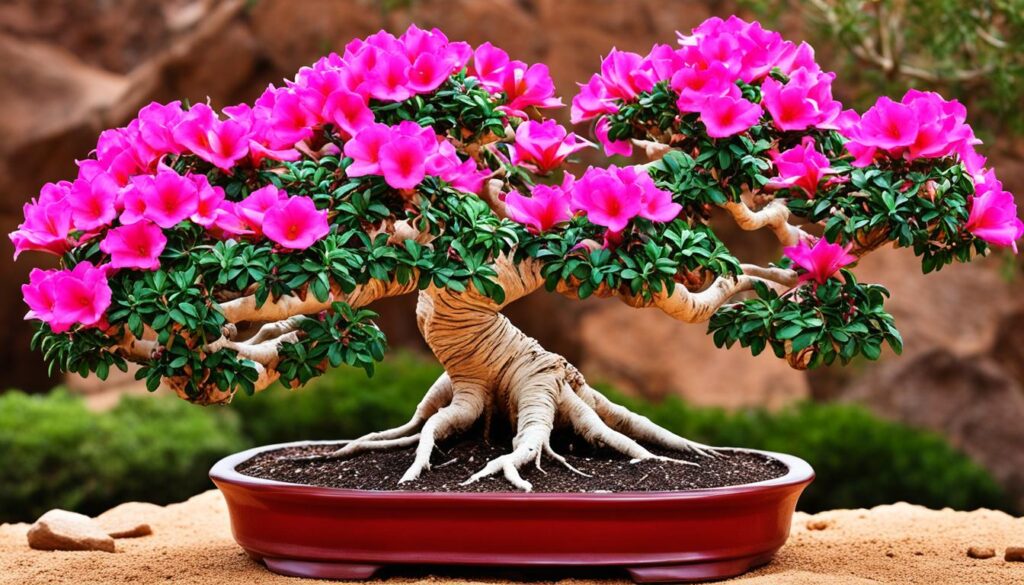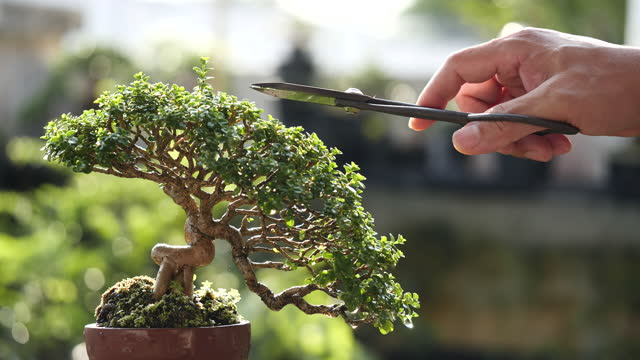Welcome to the comprehensive guide on growing and caring for Desert Rose Bonsai (Adenium obesum). Whether you’re a bonsai enthusiast or a beginner looking to embark on a new gardening journey, this guide will provide you with all the information you need to create a captivating miniature landscape with your Desert Rose Bonsai. From understanding the unique characteristics of the Adenium obesum species to optimal placement, watering, fertilizing, pruning, repotting, propagation, and common issues, you’ll discover the key secrets to success in bonsai care.
Desert Rose Bonsai, scientifically known as Adenium obesum, is an enchanting plant native to Africa, the Middle East, and Madagascar. With its thick succulent trunk, delicate leaves, and mesmerizing trumpet-shaped flowers, the Desert Rose Bonsai is a beloved species in the world of bonsai. Its ornamental value lies in the vibrant and colorful flowers that bloom in shades of red, pink, and deep purple, creating a striking contrast against its thick trunk and delicate foliage.
Optimal placement is crucial for the thriving growth of your Desert Rose Bonsai. Understanding its sunlight and temperature requirements is essential. While Desert Rose Bonsais thrive in warm climates and can be kept outside year-round in suitable regions, they require protection from extreme heat and cold. Additionally, proper watering techniques, avoiding overwatering, and providing the necessary nutrients through fertilizing play a significant role in maintaining the health and beauty of your Desert Rose Bonsai.
To enhance the aesthetic appeal of your Desert Rose Bonsai, pruning and wiring techniques are vital. Pruning stimulates ramification and encourages more flower buds to develop, while wiring helps shape the branches for a desired aesthetic. Additionally, repotting is necessary to ensure the continued health and growth of your bonsai. By following proper repotting techniques and using well-draining soil, you can ensure a healthy root system and prevent issues such as root rot.
Propagation methods, common pests, and issues that may arise in Desert Rose Bonsai are also important aspects to consider. Whether you choose to propagate through seeds, cuttings, or grafting, understanding these methods will enable you to expand your bonsai collection. By staying vigilant against common pests and promptly addressing issues such as overwatering, heat stress, and leaf drop, you can maintain the overall health and vitality of your Desert Rose Bonsai.
Stay tuned for the upcoming sections of this guide, where we will delve deeper into each aspect of Desert Rose Bonsai care. So, gather your gardening tools and get ready to embark on a journey full of grace and beauty as you discover the world of Desert Rose Bonsai cultivation.
An Introduction to Desert Rose Bonsai

Desert Rose Bonsai, scientifically known as Adenium obesum, is a captivating and unique species native to Africa, the Middle East, and Madagascar. Its distinctive features, including a thick succulent trunk, delicate leaves, and stunning trumpet-shaped flowers, make it an excellent candidate for bonsai cultivation.
Understanding the Unique Adenium Obesum Species
Adenium obesum, commonly referred to as Desert Rose, is a remarkable plant with a rich history. It has evolved to thrive in arid and dry conditions, making it highly resilient and adaptable to harsh environments. The plant stores water in its succulent trunk and can survive extended periods of drought, making it an ideal choice for bonsai enthusiasts looking for an interesting and low-maintenance species.
Popularity and Ornamental Value of Desert Rose
The Desert Rose Bonsai has gained enormous popularity as an ornamental plant, particularly in countries like Thailand, where it is revered for its striking beauty. It is admired for its vibrant and showy flowers that bloom in an array of colors, including shades of red, pink, and deep purple. The contrast between the thick trunk and the delicate foliage enhances the overall visual appeal of the Desert Rose Bonsai, making it a favorite among bonsai enthusiasts worldwide.
The Aesthetic Appeal of Desert Rose Bonsai
The Desert Rose Bonsai possesses a unique aesthetic appeal that sets it apart from other bonsai trees. Its thick succulent trunk, resembling an ancient tree shaped by harsh desert conditions, adds a sense of time and character to the bonsai. The delicate leaves and stunning trumpet-shaped flowers provide a beautiful contrast, enhancing the overall beauty and elegance of the Desert Rose Bonsai. With its captivating aesthetics, a Desert Rose Bonsai can transform any space into a miniature oasis of natural wonder.
| Desert Rose Bonsai | |
|---|---|
| Scientific Name | Adenium obesum |
| Common Name | Desert Rose |
| Native To | Africa, the Middle East, Madagascar |
| Description | A unique species well-suited for bonsai cultivation. Features a thick succulent trunk, delicate leaves, and vibrant trumpet-shaped flowers. |
| Ornamental Value | Highly popular as an ornamental plant. Appreciated for its vibrant colors and contrasting foliage. |
| Aesthetic Appeal | The distinctive trunk and delicate leaves create a visually captivating bonsai tree, adding a touch of natural wonder to any space. |
Optimal Placement for Thriving Desert Rose Bonsais
To ensure the thriving growth of your Desert Rose Bonsai, it is important to consider its optimal placement. Desert Rose Bonsais require specific sunlight and temperature conditions for their optimal development.
Desert Rose Bonsais thrive in warm climates and can be kept outside year-round in regions with a suitable climate. In temperate climates, it is best to place them outside in a sunny position or semi-shade from May to September. This allows the bonsai to receive the necessary sunlight while protecting it from extreme heat.
During autumn to spring, when the temperature drops, the Desert Rose Bonsai should be kept in a warm place indoors or in a greenhouse with ample light. It is important to ensure that the temperature does not go below 5°C/40°F to prevent damage to the plant.
Proper sunlight exposure is crucial for the Desert Rose Bonsai’s growth and development. It is recommended to place the bonsai in an area where it can receive at least 6 to 8 hours of direct sunlight per day. This will promote healthy foliage and vibrant blooms.
Note: Avoid exposing the Desert Rose Bonsai to extreme heat or cold, as it can be detrimental to its overall health.
| Optimal Placement | Sunlight Requirements | Temperature Requirements |
|---|---|---|
| Warm, sunny position or semi-shade | At least 6 to 8 hours of direct sunlight per day | Avoid temperatures below 5°C/40°F |
| Indoors or greenhouse with ample light | Protect from extreme heat or cold |
Watering & How to Prevent Overwatering your Desert Rose Plant
The Desert Rose Bonsai, being a succulent plant, possesses remarkable water-storing abilities. As a result, it does not demand excessive watering. To prevent overwatering and maintain the optimal health of your Desert Rose Bonsai, it is crucial to follow the appropriate watering technique and frequency.
Watering your Desert Rose Bonsai every 7 to 10 days allows the soil to dry out between waterings, preventing any possibility of root rot and other associated problems. A good practice is to ensure that the soil has completely dried out before watering. When watering, moisten the soil thoroughly and permit any excess water to drain out from the bottom of the pot.
Monitoring the moisture level of the soil on a regular basis will enable you to determine the appropriate watering frequency for your Desert Rose Bonsai. It is essential to adjust the watering schedule according to the prevailing climate and season, reducing the amount of water during the dormant winter period.
Fertilizing Your Desert Rose Bonsai for Best Results

Proper fertilization is essential to provide your Desert Rose Bonsai with the necessary nutrients for healthy growth and vibrant blooms. By understanding the nutrient requirements of your bonsai and choosing the right fertilizer, you can ensure that your Desert Rose Bonsai thrives in its miniature landscape.
From spring to autumn, it is recommended to use a liquid fertilizer specifically formulated for bonsai at half the recommended strength. Apply the liquid fertilizer once a month to supply the required nutrients for optimal growth. Liquid fertilizers are easily absorbed by the bonsai’s roots, promoting healthy foliage and flower production.
In winter, the Desert Rose Bonsai does not require regular fertilization unless it is actively growing new shoots. During this dormant period, you can enrich the soil with a solid organic fertilizer. Solid organic fertilizers release nutrients gradually, providing a sustained source of nourishment for your bonsai.
Always follow the recommended dosage and instructions provided by the fertilizer manufacturer. Over-fertilizing your Desert Rose Bonsai can lead to nutrient imbalances and harm the plant’s overall health. By fertilizing your bonsai appropriately, you can support its growth and enjoy its stunning beauty for years to come.
| Fertilizer Type | Application Period | Dosage | Bonsai Stage |
|---|---|---|---|
| Liquid Fertilizer | Spring to Autumn | Half the recommended strength | All stages of growth |
| Solid Organic Fertilizer | Winter (if actively growing) | Follow manufacturer’s instructions | Active growth stage |
Desert Rose Bonsai Care: Pruning and Wiring Techniques

Pruning and wiring are essential techniques to maintain the shape and aesthetic appeal of your Desert Rose Bonsai. By regularly pruning and utilizing proper wiring, you can ensure the health and beauty of your bonsai tree.
Pruning is a year-round practice that stimulates ramification, encourages flower bud development, and maintains the overall shape of the Desert Rose Bonsai. To prune your bonsai tree, trim back long shoots and remove any damaged parts. Make clean cuts just above a leaf node or junction to promote healthy growth.
When wiring the branches of your Desert Rose Bonsai, take care not to wind the wire too tightly. Tightly applied wire can cause wire marks and scarring on the branches, which the bonsai tree is susceptible to. Proper wiring allows you to shape the branches and guide their growth, creating the desired aesthetic form for your bonsai.
Timing is crucial when it comes to pruning and wiring. It is best to coincide these practices with the growth and flowering patterns of the Desert Rose Bonsai. By understanding the natural rhythms of your bonsai tree, you can achieve the desired shape, promote overall health, and enhance flower bud development.
How to Repot Desert Rose Bonsai for Continued Health
Repotting is a crucial aspect of maintaining the health and growth of your Desert Rose Bonsai. By repotting every two or three years in late spring, you can ensure that your bonsai has ample space for root development and access to fresh nutrients.
To successfully repot your Desert Rose Bonsai, follow these steps:
- Choose the right time: Late spring is the ideal time to repot your bonsai when the plant is actively growing. This period provides the best conditions for the root system to recover quickly.
- Prepare the tools: Gather the necessary tools, including a bonsai rake, root pruning shears, and a suitable bonsai pot.
- Root pruning: Carefully remove your Desert Rose Bonsai from its current pot. Inspect the roots and prune any dead or damaged ones using root pruning shears. This process encourages new root growth and improves the overall health of the plant.
- Choose the right soil: Use a well-draining soil mix specifically formulated for succulents, ensuring that excess moisture doesn’t accumulate in the pot. This helps prevent root rot, a common issue for Desert Rose Bonsais.
- Repositioning: Place a layer of soil at the bottom of the new pot and position your Desert Rose Bonsai, ensuring that it sits slightly higher than the previous level. Gently add soil around the roots, pressing it down to eliminate air pockets.
- Watering and aftercare: After repotting, water your Desert Rose Bonsai thoroughly to settle the soil and promote root establishment. However, avoid watering for a few days to allow the plant to recover from the stress of repotting.
It’s important to monitor the growth rate of your Desert Rose Bonsai and the size of the pot to determine when repotting is necessary. Observe the root system and choose a pot that allows for adequate space for future growth. Remember, repotting frequency may vary for each individual plant.
Propagation, Pests, and Common Issues in Desert Rose Bonsai
Now that you have learned how to grow and care for your Desert Rose Bonsai, let’s explore propagation, pests, and common issues that you may encounter along the way.
When it comes to propagating your Desert Rose Bonsai, you have several options. You can start from seeds, take cuttings, or opt for grafting. Grafting is a popular method, particularly in large Southeast Asian nurseries, and it allows you to combine different varieties for unique and stunning results.
Like any plant, Desert Rose Bonsais can be susceptible to pests. Common culprits include aphids, mealybugs, and spider mites. However, with regular care and ideal growing conditions, you can help prevent infestations. If necessary, there are appropriate pest control measures available to combat these unwelcome visitors.
While the Desert Rose Bonsai is generally a resilient plant, it can face some common issues. Overwatering can lead to root rot, so it is important to maintain proper watering practices. Additionally, leaf yellowing may occur due to heat or sun stress, requiring you to adjust the plant’s placement accordingly. Finally, leaf drop during winter is a natural response to seasonal changes. By promptly addressing these issues, you can ensure the overall health and vitality of your Desert Rose Bonsai.

Karen Phillips, Bonsai expert and blogger. Read more about me here



